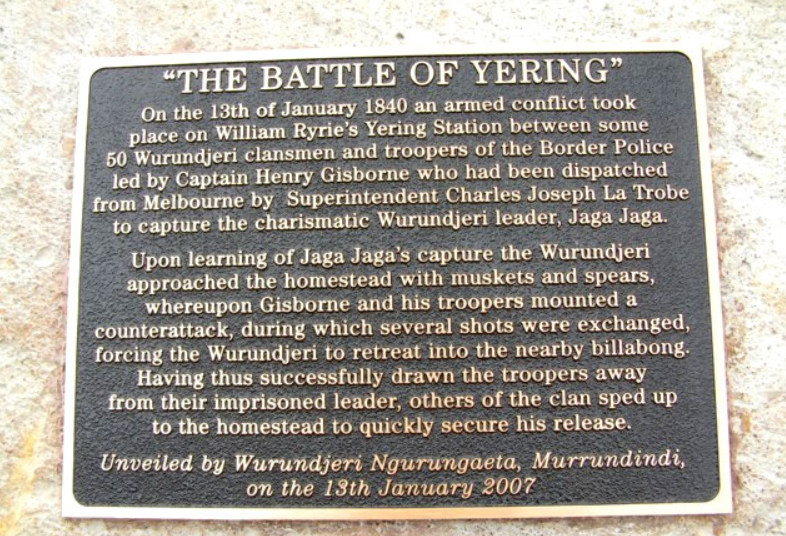
In the course of recent research into the boundary that existed between the Bunurong and the Wurundjeri at the time of contact with Europeans, I came across a reference to the historical marker on the Melba Highway between Chateau Yering and Vasey Houghton Bridge, Yarra Glen. I went and looked at it: it commemorates a “battle”.
The inscription on the monument reads:
Battle of Yering
On the 13th of January 1840 an armed conflict took place on William Ryrie’s Yering Station between some 50 Wurundjeri clansmen and troopers of the Border Police led by Captain Henry Gisborne who had been dispatched from Melbourne by Superintendent Charles Joseph La Trobe to capture the charismatic Wurundjeri leader, Jaga Jaga.
Upon learning of Jaga Jaga’s capture the Wurundjeri approached the homestead with muskets and spears, whereupon Gisborne and his troopers mounted a counterattack, during which several shots were exchanged, forcing the Wurundjeri to retreat into the nearby billabong. Having thus successfully drawn the troopers away from their imprisoned leader, others of the clan sped up to the homestead to quickly secure his release.
Unveiled by Wurundjeri Ngurungaeta, Murrundindi, on the 13th January 2007
This text is modest and restrained, but it does go beyond the primary evidence. The primary evidence is in the form of a hastily written account of what happened, written on the spot and witnessed by William Ryrie who saw the events. Ryrie recorded that Captain Henry Fysche Gisborne fired one shot only, and his men obeyed orders and did not fire at all. Gisborne wrote a report for La Trobe in which he states that he fired his pistol at retreating Wurundjeri from a distance of seventy yards, and confirms that his men kept to their orders and did not fire at all.
So the stone memorial goes beyond the primary evidence in the direction of exaggeration. The accompanying illustration is an imaginative reconstruction, incorrect on two counts—the Wurundjeri did not retreat across the Yarra River, they retreated into the reedbeds of the lagoon/swamp, and shots were not exchanged.
This essay appeared in a recent Quadrant.
Subscribers had no need to wait for the paywall to come down
The local newspaper the Mountain Views Mail published a report of the stone’s unveiling in January 2007, with a photograph of the participants: the reporter was Kath Gannaway. Her report explains that the memorial was organised by the Friends of the Yarra Flats Billabongs, the Nillumbik Reconciliations Group, and the Yarra Ranges Friends in Reconciliation. The Yarra Ranges mayor, Tim Heenan, councillor Jeanette McCrae, and Nillumbik mayor Warwick Leeson were present. Wurundjeri elder Murrundindi performed a smoking ceremony. The main speaker was the local historian Mick Woiwod. In his remarks, he escalated the “battle” to a “serious armed confrontation” in which there was an unknown number of casualties, and about which the records were “sanitised”. Gannaway’s text reports:
Local historian Mick Woiwod said Melbourne was very much a frontier settlement when the 50 Aboriginal men led by Jaga Jaga found themselves in what was the first serious armed confrontation with authorities.
Mr Woiwod said the men had left Melbourne on “men’s business” on 12 January 1840. The incident started when they raided a vegetable garden of a settler named Anderson at what is now Warrandyte.
“When he ordered them off his land—land they probably saw as their land—a shot was fired which narrowly missed Anderson’s head,” Mr Woiwod said.
The men moved on to a spot near William Ryrie’s Yering Station and troopers followed. In conjunction with Mr Ryrie, the police lured Jaga Jaga and some of the Wurundjeri men to the station where the confrontation took place.
“All we have today is a very sanitised report with no mention of deaths, and today no-one knows how many Wurundjeri may have fallen in that confrontation,” Mr Woiwod said.
He said it was important to acknowledge the events of the past. “Reconciliation is about acknowledging, it’s not about guilt,” he said. “We can’t change what has happened in the past, but we must acknowledge that it happened.”
The cultural heritage department of the Yarra Ranges Shire escalates the event yet again, describing the “battle” in its official Guide to Heritage in the Yarra Ranges as the start of a “three year land war”.
This is plainly and simply wrong.
No professional historian who has published in the area of early colonial history would agree that there was a three-year Wurundjeri war from 1840. Even the Wurundjeri as a group, the Wurundjeri Woi Wurrung Cultural Heritage Aboriginal Corporation, don’t claim that. It is light years away from truthfulness. These are the years in fact when the Wurundjeri co-operated with other groups and with Europeans in founding the two most significant institutions of the 1840s—the Protectorate and the Native Police Corps.
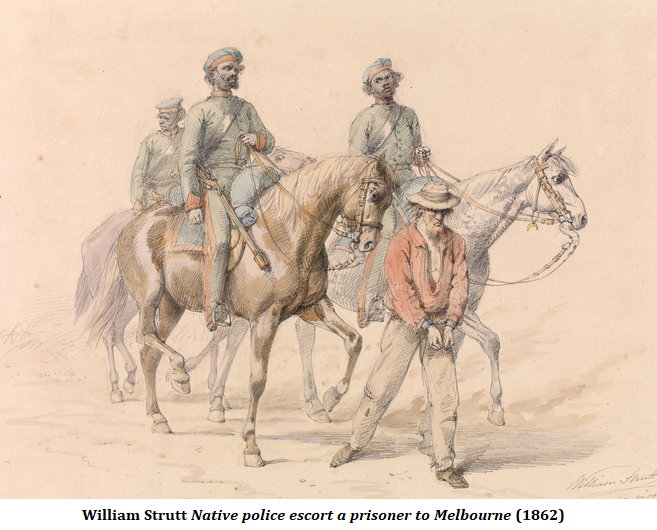
The problem for the present is that the text on the stone memorial, the words of the speaker at the dedication and the text of the Shire’s Guide—all sympathetic to the Aboriginal cause, as am I—are all a long way from the evidence. My point is that we can’t make it up, no matter how well-meaning our motives.
Acknowledgment of the past—telling the truth—usually requires painstaking primary research in archives. Truth-telling in history is not a work of the sympathetic imagination, nor is it a product of ideology. And for this event, and this memorial, and this official guide, the hard work has not been done.
Ignoring Mr Woiwod’s factual errors, his assertion of unknown casualties, and his allegation of sanitising of records, ups the ante considerably. These are serious matters for which no evidence is offered.
It seems that at no stage in this escalation process has anyone searched for, and found, and critically examined, the primary documents in the Public Record Office of Victoria. For this, the Cultural Heritage department of the shire must take responsibility. The amateur reconciliation groups that sponsored the memorial could not be expected to have the research skills and the access to the Public Record Office of Victoria to do the work necessary before a public monument in a public park was constructed. I inquired of the Yarra Ranges Community Heritage Officer as to the sources used for the official guide to the memorial. This officer replied that “the information was sourced from a variety of different groups across the Yarra Ranges so I can’t speak to sources”. Oh dear! And when I asked a second time to be given the sources on which their Guide relied, and the text on the stone memorial relied, it was recommended that I contact the reconciliation groups themselves.
So how did we get a public memorial (below at its dedication) in a public park in a tourist area, whose unveiling was graced by dignitaries, commemorating an event about which such extraordinary claims are made, in the absence of a thorough inquiry into the primary records?
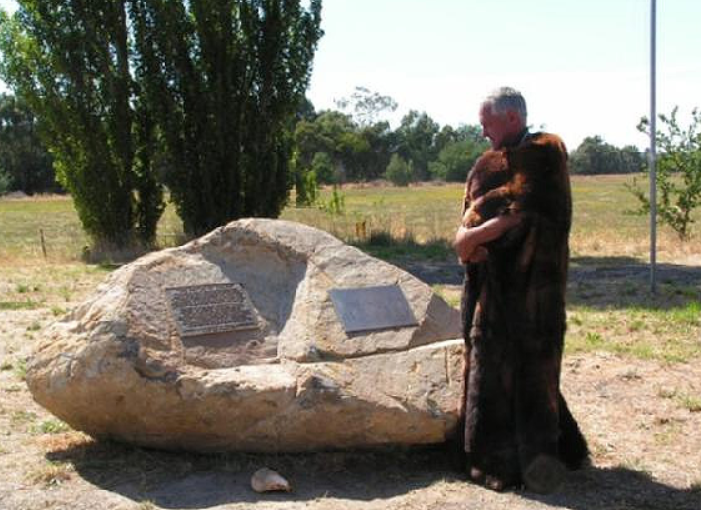
In trying to discover the sources from which the pastiche of misinformation was constructed, two local residents gave me a start, for which I am indebted, and I thank them. The president of the Lilydale Historical Society referred me to a 1994 privately published local history—The Shire of Lilydale and its Military Heritage, Volume 1: The Colonial Years, by Anthony J. McAleer. This little book has a chapter, “The battle of Yarra Flats”, which proposes the so-called battle as the start of a guerrilla war lasting till 1842. In its turn, this book lists in its bibliography an eight-page pamphlet, Yarra Valley Aborigines by Leigh Blackburn.
Leigh Blackburn, a successful professional man, was the founder of the Lilydale and District Historical Society. He is the epitome of the enthusiastic local historian, caring about the past, committed to preserving its traces, willing to fight for a museum, for gathering oral histories of pioneers, researching some topics himself—he was particularly interested in local resident Dame Nellie Melba and the Mahogany Ship on the west coast of Victoria. I have worked for years with people like Leigh Blackburn in my own local historical society. Without people like him there would be no local history, no one to galvanise interest in the past, to work with local councils and shires in the public interest. But—he lacked knowledge and understanding of Aboriginal/European relationships in the Port Phillip District in the 1840s and his pamphlet is full of factual errors; it lists no sources. His pamphlet is the source of the ideas subsequently repeated—“almost a guerrilla war”, “gun battle with troopers” and the suggestion that this event led to “the public hanging of three natives in Melbourne later in 1842”, within the time frame of the alleged war. The two Tasmanian Aborigines, Tunnerminnerwit and Maulboyheener, known locally as Bob and Jack, were hanged for the killing of two whalers at Westernport. There is no relationship at all with this event at Yering.
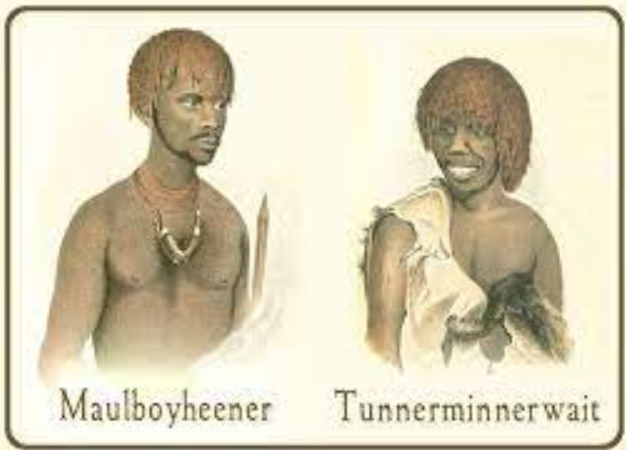
The second resident is the Abbot Emeritus of the Cistercian Abbey at Tarrawarra, who referred me to the published Ryrie family history—The Ryrie Family: Australian Pioneers, by a family member, John H. Edwards, who asserts that the records were “cleaned up”. Edwards found, in the Public Record Office of Victoria, the original of Commissioner of Crown Lands, Henry Fysche Gisborne’s letter to La Trobe reporting the incident at Ryrie’s station at Yering. William Ryrie was an eyewitness to the events. As Edwards correctly points out, this letter differs from that published in Historical Records of Victoria. But the published version in HRV is not a cleaned-up version as Edwards asserts—it is a different source. It is the copy clerk’s abbreviated version, a draft in Gisborne’s Outward Letter Book: it is written in a different handwriting from Gisborne’s, and its purpose was the same as any other government copy clerk’s work—so that Gisborne had a record of the letters he wrote—it might be thought of as nineteenth-century carbon paper. There is no smoking gun here—it is a simple and understandable mistake by an amateur family historian.
The Mount Evelyn History Group has published a small book, Aborigines in the Yarra Valley and Northern Dandenongs, which sees the “Battle of Yarra Flats” as “the first serious confrontation of a three-year guerrilla war between this group of Aborigines and the authorities”. Their reference is McAleer.
The primary sources for the false historical information appear thus to be an assertion from an ideological perspective, an assertion based on a mistake, and assertions which are merely exaggerations. They are shaky grounds for writing history. They are especially to be regretted at a time when the issues of conflict and war are in the forefront of public consciousness.
An outline of the event
There certainly was an event in the second week in January 1840, but it was hardly a battle. 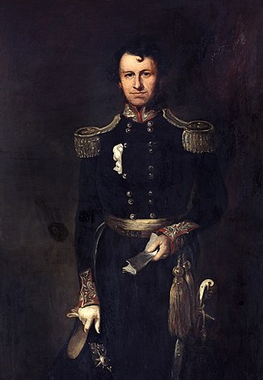 Superintendent Charles Joseph La Trobe (left) ordered Commissioner of Crown Lands Henry Fysche Gisborne to go up the Yarra and apprehend a Wurundjeri man named Jackie Jackie, whose real name was Burborough. He was wanted for stealing potatoes from James Anderson’s paddock at South Yarra, and for allegedly firing at him.
Superintendent Charles Joseph La Trobe (left) ordered Commissioner of Crown Lands Henry Fysche Gisborne to go up the Yarra and apprehend a Wurundjeri man named Jackie Jackie, whose real name was Burborough. He was wanted for stealing potatoes from James Anderson’s paddock at South Yarra, and for allegedly firing at him.
Gisborne went up the Yarra with three men—two troopers of his own Border Police, and one mounted policeman on secondment from his job as part of the British Army regiment guarding convict prisoners in Melbourne. Gisborne had returned two of his own Border Police to Sydney for drunkenness, and he borrowed a trooper from the Army.
He and his troopers found about fifty Aborigines at William Ryrie’s station at Yering, encamped on the edge of scrub and a deep swamp, about half a mile downhill from Ryrie’s house. This distance is important—we are talking of an event that took place within a small area. Gisborne spoke to some of the blacks and discovered that they had seven muskets and an unknown number of pistols in their possession, some of the guns, according to their story, given to them by the Chief Protector George Augustus Robinson. After interviewing the blacks, and discussing it with Ryrie, Gisborne formed a plan to apprehend Jackie Jackie later in the day when the blacks were expected to come up to the house to watch a bullock killed and to receive their share.
Gisborne’s plan was as follows: the blacks would come up to the house as they customarily did when a beast was killed, whereupon Gisborne would ride down to their camp, seize the firearms, then ride back up the hill to Ryrie’s house and seize Jackie Jackie.
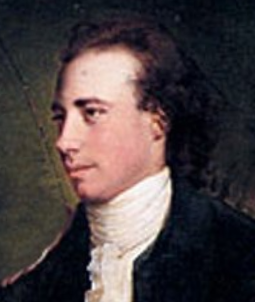 But matters didn’t go according to plan. About thirty of the blacks duly came up from their camp at the expected time carrying only their fishing spears: possibly, even probably, they were all males. (It is by the way a big overclaim to say that the so-called battle was between fifty of the Wurundjeri and Gisborne (right). Fifty was the estimated number of the whole group including women and children.) And equally, it is a simple invention on Murrundindi’s part to state that their journey from Melbourne was on men’s business. There is just no evidence for that, and to the contrary, we know from Assistant Protector William Thomas’s journal that men, women and children of this patriclan of the Wurundjeri routinely spent January and February there on their home country that the Ryries had squatted on.
But matters didn’t go according to plan. About thirty of the blacks duly came up from their camp at the expected time carrying only their fishing spears: possibly, even probably, they were all males. (It is by the way a big overclaim to say that the so-called battle was between fifty of the Wurundjeri and Gisborne (right). Fifty was the estimated number of the whole group including women and children.) And equally, it is a simple invention on Murrundindi’s part to state that their journey from Melbourne was on men’s business. There is just no evidence for that, and to the contrary, we know from Assistant Protector William Thomas’s journal that men, women and children of this patriclan of the Wurundjeri routinely spent January and February there on their home country that the Ryries had squatted on.
Gisborne and his men were dismounted, having put the horses and accoutrements (including their arms) out of sight. But Jackie Jackie appeared suspicious—he had recognised the Commissioner of Crown Lands immediately, and started to move away. Gisborne called out to William Ryrie to delay him, and while Ryrie and Jackie Jackie spoke, Gisborne walked behind them, linked arms with Jackie Jackie and called up his men. Gisborne’s three troopers then managed to subdue Jackie Jackie after a desperate ten-minute struggle. (This Jackie Jackie was actually known as Big Jackie Jackie—over six feet tall, powerfully built and immensely strong.) They restrained him with handcuffs and a rope around his ankles. Jackie Jackie yelled, and the Wurundjeri rushed to assist him. Gisborne put a gun to the head of the first man to approach, and told the rest to back off, which sensibly, they did, haring off to their camp half a mile away, and returning with their firearms as well as spears. By this time Jackie Jackie was lodged in a hut. His father, Old Jackie Jackie, stayed with him.
When the returning Wurundjeri approached to within range of a musket shot, Gisborne gave his men the order to mount, particularly commanding them not to fire without orders. The four mounted men then “followed” the Wurundjeri, while the Wurundjeri fired “several shots” at Gisborne and the troopers. Gisborne chased the Wurundjeri into the deep swamp and Gisborne fired one shot only, from his pistol, at a distance of seventy yards—a useless gesture, as a pistol shot of the time might travel twenty to thirty yards. Presumably he fired out of frustration; it was certainly a lapse of professionalism, for which he apologised to La Trobe. He stressed to La Trobe that his men followed orders, held their discipline and did not fire at all. His troopers were a mixed group: Troopers Hoonohan and Reilly were Border Policemen, escorts for the Commissioner of Crown Lands as he rode the country on government business, while Corporal Dundas was a regular mounted policeman, an Army redcoat, borrowed from the Mounted Police.
While Gisborne and his troopers were “following” the Wurundjeri who fired the shots, other Wurundjeri broke into the hut, cut Jackie Jackie’s rope, and he fled with the handcuffs still on. Gisborne was so upset (chagrin? embarrassment? frustration? anxiety about the consequences?) that he wrote a record there and then of what happened, and showed it to William Ryrie who witnessed the event and who said that as far as he observed the account was “minutely correct”.
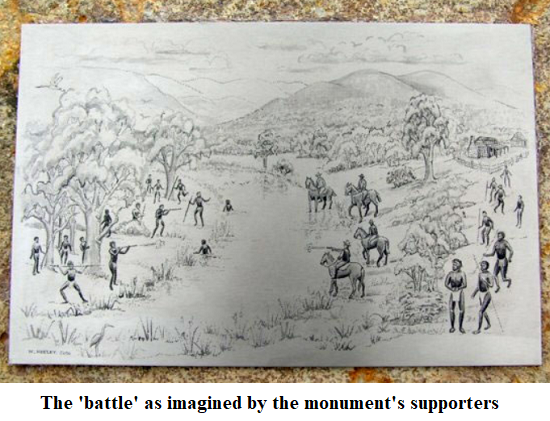 I have my questions though about two issues. The first is that while it might have been minutely correct to use the word following (technically Gisborne and the three troopers did follow the blacks), I suspect that they didn’t just politely walk their horses after the blacks into the swamp. The mere fact that the blacks ended up in the swamp suggests they were chased—that Gisborne and his men cantered or galloped after them. So the record might be minutely correct, as William Ryrie attested, but as written it probably didn’t convey the drama.
I have my questions though about two issues. The first is that while it might have been minutely correct to use the word following (technically Gisborne and the three troopers did follow the blacks), I suspect that they didn’t just politely walk their horses after the blacks into the swamp. The mere fact that the blacks ended up in the swamp suggests they were chased—that Gisborne and his men cantered or galloped after them. So the record might be minutely correct, as William Ryrie attested, but as written it probably didn’t convey the drama.
The second doubt I have is about the tying up of Jackie Jackie. As written, it appears that his arms and his ankles were tied separately. But one scholar who read this report interpreted the evidence differently by suggesting that there might have been a connecting rope between the arms and the legs—that Jackie Jackie was hog-tied. If this were so, it would have been a frightful indignity for the Wurundjeri leader.
In Gisborne’s formal report to La Trobe, he apologised for messing things up. More importantly, he noted that though the Wurundjeri were aiming deliberately, every shot they fired missed:
There could be no mistake as to what was their intention as the balls came whirring past us, and striking objects close to us every minute, but I am unable to account for their never having hit us, as they are capital marksmen.
And he was at pains to stress that his men held their discipline, obeyed orders and did not fire at all.
Was this a battle?
With an unknown number of shots fired from a possible total of seven muskets by one side, and on the other side one pistol shot fired which had no hope of hitting its target, it can hardly be called a battle. Even from a technological perspective, a “battle” is not possible. The Brown Bess musket, which the British Army was still using in the 1840s, was what the Wurundjeri must have had because it was the only musket available to the settlers from whom the Wurundjeri obtained them. It was four feet long, was carried in a sling, unloaded, could not be loaded on horseback, was hopeless in wet or humid conditions (hence the common phrase, “Keep your powder dry”), could fire only ten shots in four and a half minutes, and according to British Army tests in 1838, misfired 822 times in a test continued to 200 successful shots. The flintlock was a mechanism for calm and disciplined occasions, such as shooting stationary game, or firing into the front rank of an enemy in a set piece battle.
It appears to be the case that when Jackie Jackie was captured, the Wurundjeri raced down to their encampment and collected their guns, ran back up the slope and loaded them behind the trees at musket range from Ryrie’s house, fired, then fled again for the swamp (because they couldn’t stand still to reload) chased by Gisborne and his troopers on horseback. Anyone who watched the loading of a musket would have grave doubts that the blacks would have run half a mile uphill with a loaded weapon. And who would stand still and take all that time to reload once Gisborne and his troopers mounted and started to “follow” them?
It seems to me that it was a controlled response on the part of the Wurundjeri to a high level of provocation: it was, and is, impressive. Everyone knew, including La Trobe, that the blacks were “capital shots”. So for every single man who had a musket to take deliberate aim, within target range, but still miss, cannot be a coincidence. I interpret this shooting at Gisborne, but shooting to miss him, and his three troopers, and their horses, as a clever and powerful gesture towards authority; to use a vulgar expression, they were giving Gisborne the two-fingered salute. It was controlled defiance.
There are numerous examples in the journals of Assistant Protector William Thomas of the blacks firing their guns to express their feelings. He mentions one example at Ryrie’s a year later. Beruke/Gellibrand fired off his gun in the middle of a debate which Thomas considered “was indicative of his indifference to my Authority”.
They did it again to Mr Arthur at his station on the Plenty River in early May. Lieutenant Frederick Russell and his mounted police (British Army redcoats) went up on La Trobe’s orders to investigate an alleged “outrage”. Russell’s report demonstrates a degree of nonchalance in judging the blacks’ actions. He says:
It does not appear that the Aborigines committed any greater outrage than stealing a few bags of potatoes from the station store mentioned, although they presented their arms in a threatening manner when desired to leave the place.
And they did it again, more or less, to Russell and his Mounted Police later in May 1840. Following Gisborne’s failure, Russell had been sent up to Ryrie’s three months later to take away the Wurundjeri men’s arms. Russell and his men were attempting to cross a “difficult and dangerous” ford on the upper Yarra when the ominous sound of two distinct clicks came from the scrub on either side of them. They didn’t heed the warning but pressed on. Further up the river they were ambushed—shot at from both sides from “impenetrable scrub”; the Wurundjeri fired several shots (the newspaper account says three) and “slightly wounded” three of the troopers. Here again, there are big targets—red-coated troops, on horses, moving slowly, if at all: the ambushers were stationary and concealed, and yet the Wurundjeri inflicted only slight injury. Three shots and three hits, and only slight injuries: they do seem to have been capital shots. It is a pity that Russell was not more forthcoming over the nature of the “slight injuries”. But we do know that the Wurundjeri were in a position to wipe out Russell’s force had they wished. It seems to me that they were toying with the authorities, thumbing their noses at them.
Russell’s report stated that he “drove them from their cover and dispersed them”, and those words rang alarm bells in Sydney, with a swift response from the Colonial Secretary to La Trobe stating that the Governor wished to know exactly what Russell meant by “dispersing” the blacks, asking whether force of arms was used, and re-stating the Governor’s policy that in the event of a black death, an inquiry must be held. I haven’t found Russell’s further explanation, but it satisfied the Governor because his response later that year in August is on record as recommending “no further action”.
Gisborne’s integrity
Whether or not we can accept Gisborne’s on-the-spot record of the event depends on his truthfulness, and Ryrie’s. Though Gisborne was young, an English gentleman born and educated (Eton and Cambridge) he was experienced in the colony of New South Wales. He spent two years as a police magistrate in Sydney and another year as Governor Sir Richard Bourke’s private secretary. More to the point, he had spent a further full two years as police magistrate in the Wellington Valley, a recent frontier situation, one of the oldest west of the Blue Mountains.
The Wellington Valley had been a region of such conflict that martial law had been declared in the 1820s. But Gisborne arrived in 1837, well after this period of conflict. His biographer states that “at an official inquiry into the rivalry between settlers and missionaries at Wellington, Gisborne’s evidence showed him a clear thinker and a fluent speaker”. The Anglican Church Missionary Society founded the mission in 1832 with German Lutherans as pastors. The New South Wales government gave the mission 10,000 acres and £500. It closed in 1842, with internal theological problems being part of the reason, together with external disputes with settlers over Aboriginal interests.
Marnie Bassett, writing in the Australian Dictionary of Biography, found nothing to criticise about Gisborne, and there is no hint in Port Phillip that he was anything but an honourable gentleman—and the code of honour of English gentlemen precluded lying.
He was in poor health. Governor Gipps found him to be active and intelligent in Sydney, but in Melbourne Superintendent La Trobe thought that he was lazy. In fact he resigned his position a year later, and died at sea on the voyage back to England. He bore the reputation of being a calm and sensible administrator as well as an ardent worker for the separation of Port Phillip from New South Wales. He was so active in society—in horse-racing (he is acknowledged as the founder of Flemington racecourse), literary society (on his departure for England, he left his extensive library as a gift to the people of Melbourne), gentlemen’s clubs, separation politics—that had there been any doubts about his integrity, there would be traces of evidence to find. There are none. I for one, accept the account as written.
Was there a three-year Wurundjeri war?
That there was no war is made abundantly clear by subsequent activities. Two days after the abortive attempt to arrest Big Jackie Jackie, William Ryrie was in Melbourne to attend a dinner of the Caledonian Society at the Lamb Inn. Next day he sold 300 cattle at auction in Melbourne. At the very least, Ryrie is not exhibiting disquiet about his station immediately after the so-called battle.
As for the response of the authorities, it seems rather ho-hum. Two months after the Gisborne fiasco, on March 16 (before Russell’s two May adventures) La Trobe himself went up to Ryrie’s accompanied by Lyon Campbell and Archdeacon Jeffries. It was only La Trobe’s second journey outside Melbourne (his first was to the west, to Geelong and Buninyong). It was a four-day trip, with two full days spent at Ryrie’s. La Trobe’s main purpose seems to have been to read the riot act to the Murrays. La Trobe’s journal notes that he had a meeting with “Murray’s band” who were living in the scrub by the river over the flat. He notes that they are “only half friendly” and that Ryrie had influence with them. The Chief Protector and the Assistant Protector confirmed that Ryrie was friendly with the blacks and good to them. It all seems low-key—there is no war here.
Murray’s band, as La Trobe describes them, were a division of the Wurundjeri who owned the country south of the Yarra from the source of the Yarra in the mountains down to Gardiner’s Creek at Burnley, including the northern slopes of the Dandenong Ranges. Their ngaraeta was Old Jackie Jackie/Old Murray/Boronuptune, and his sons were Big Jackie Jackie/Burburough/Boro Boro/George (the potato stealer), Waverong/Young Murray, who joined Dana’s Native Police Corps two years later, and McNall/Perpine likewise.
Gisborne’s original instructions from La Trobe commenced with a directive to consult the Chief Protector, George Augustus Robinson. Gisborne had duly called on him, but Robinson was away in the Western District. Gisborne went then to the Assistant Protector William Thomas, but he was away in Westernport near Lang Lang. So Gisborne set off with just his three troopers.
The day after La Trobe returned to Melbourne from Ryrie’s, on March 20, 1840, Robinson, just back from the Western District, had an interview with him about various matters, including La Trobe’s visit to Ryrie’s. In his idiosyncratic prose, Robinson recorded in his journal:
Mr La Trobe said he had been to Ryree’s station and seen the blacks who had attack Gisborn, i.e. McNall and Borro Borro, and had an interview with them and told them not to come to Melbourne.
That interview was on a Friday. On the following Monday, Robinson recorded the following:
This morning Gellibrand (another Wurundjeri) came and reported the Balleyang i.e. Geelong blacks had arrived, I understood him to say either last night or this morning, and had speared him and Turnbull (Ningolobin, Mt Macedon chief), and that he was going to Ryrees to get the other blacks to come and fight them. I told him to do no such thing as superintendent stated that if McNall and Borro Borro came to Melbourne they would be put in gaol, and if the natives were not quiet they would all be sent away from Melbourne.
The Port Phillip Herald confirms this—the notorious Jacky Jacky and his tribe have not made their appearance in town since Mr Gisborne’s affray, but about the middle of last week, the women and children came into town evidently having been sent as pioneers to feel the way and ascertain whether the excitement occasioned by Jacky Jacky’s affair had sufficiently subsided to admit of the tribe making their appearance without risk. Apparently the experiment was satisfactory, for a few days afterwards the men also arrived. The newspaper notes that now 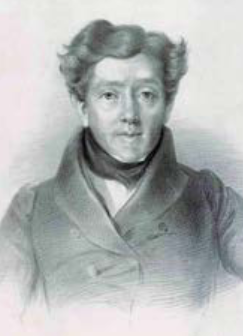 twenty Barrabools have arrived for a big fight, noting that at no time does there exist a good understanding between the Melbourne and Barrabool blacks.
twenty Barrabools have arrived for a big fight, noting that at no time does there exist a good understanding between the Melbourne and Barrabool blacks.
We can only wonder what the blacks made of their interview with La Trobe. Robinson (right) seems quite clear that according to La Trobe himself, he told them to stay away from Melbourne, yet the men turned up in Melbourne two days later, and the women and children had been there for a week or so. It certainly looks as though Jacky Jacky’s mob were pursuing their own agenda. And it clearly isn’t a war.
The next Europeans to visit Ryrie’s were the Chief Protector George Augustus Robinson, and the Assistant Protector William Thomas, who were scouting for a tract of land suitable for a Protectorate station. They visited on August 29, 1840, about six months after the event. Both men recorded that they were well and hospitably received by Ryrie, and Robinson recorded his view on the event at Yering: it is a retrospective view, appearing in the text after Ryrie’s but actually referring to Anderson’s station a mere few miles up the Yarra from Bolin (Bulleen):
I should have remarked that after leaving Mr Thomas’ camp yesterday we passed Major Newman family … leaving Newman at which I did not call, passed over a thickly timbered forest range for three miles and came to a station … where a Mr Anderson, a new settler, a Scotchman was settled … this person has been here but a short time—12 or 18 months, and has established himself pretty comfortable … It was here that the fraca took place with the blacks when Commissioner Gisborne exhibited his prowess. It seems that the blacks had stolen some potatoes from a paddock in a secluded part of the station at least a half a mile from their [Anderson’s] hut. As soon as Anderson found it out he went up to the natives camp and accused the natives and threatened them, and as he says, a gun was fired at him—whether this was the case or no, the natives deny it. Anderson says they did. It is probable that a gun was fired. Perhaps they did it to intimidate him especially as he was threatening them which was most indiscreet especially in such a sequester spot. The man however was not injured in the least, his fears may have overcome him, he being a stranger to the blacks. Be it as it may be, it was wrong to place temptation in this way by having a paddock so far from his hut, as I told him that white men much less savages would steal potatoes to satisfy cravings of hunger especially when met with in such a secluded spot. The man insisted that he had watched several nights, and probably with firearms, but they had evaded him. This stealing of potatoes was cause of the commissioner Gisborne attack upon the natives at Ryrees. Wither the commissioner and Border Police followed them at least 20 miles from Andersons. At Ryrees they laid a trap for them. The natives were always well treated at Ryrees and this day they came to get the offal of a beast that was slaughtered when by a preconceived signal Gisborne’s men seized Jaggy Jaggy or [blank] by their own and tied him. It took four or five men to hold him. He being secured the other natives seeing it came to the attack where the border or rural police rode after them. They returned in good order and shots were fired. Mr Gisborne fired his pistol, the first shot, when the natives retaliated and drove the police back. Jacky Jacky during the fraca, and being left alone got his hands at liberty. This was a bad business of the Border Police. They had better never had attempted it. It was at this time that they took away the guns from my VDL natives at the same station. The Waverong blacks are a well disposed race of people if left alone. I had some communication with Anderson on the subject of the blacks. He did not know me.
After this, there seems not to have been any serious affray or confrontation or outrage or collision between the Wurundjeri and the Europeans, at all. Certainly, some Wurundjeri were caught up in Major Lettsom’s infamous round-up on the Heidelberg road in October 1840. But that was by accident. Put briefly, Major Lettsom and a detachment of the Mounted Police from Sydney had followed a large mob of Goulburn blacks from their own country, all the way down the Sydney road to Melbourne, then rounded up with force about 300 persons, including some Wurundjeri who had met the Goulburns in Melbourne and were merely socialising. Strong positive relationships existed between the Wurundjeri and the Goulburn blacks. Thomas extricated the Wurundjeri from custody by providing alibis—he was able to prove that they were not present at the original event because they  were with him. But this event is well known to historians (and the Wurundjeri): the important man Winberri/Windberry was shot dead by a soldier in the act of raising his waddy. It was not part of any Wurundjeri uprising.
were with him. But this event is well known to historians (and the Wurundjeri): the important man Winberri/Windberry was shot dead by a soldier in the act of raising his waddy. It was not part of any Wurundjeri uprising.
About a year after the Wurundjeri shot at Gisborne, Assistant Protector Thomas (left) was at Yering from February 12 to February 26, with more than 100 combined Wurundjeri and Bunurong, as well as sixty Goulburn blacks for part of the time. This is not war.
In 1842, the Wurundjeri constituted the greatest percentage of enrolees in Henry Edmund Pulteney Dana’s Native Police Corps. The Wurundjeri contingent included Billibelary, the Chief (who said on enrolling that he was a king so he wouldn’t do drill like the others), and the Big Jackie Jackie of this story, whose real name was Burborough, and Perpine/McNall, and Waverong—these latter three being part of the division of the Wurundjeri who owned Ryrie’s country and south of the Yarra down to Gardiner’s Creek.
And this isn’t war.
Conclusion
The key to understanding this event is Gisborne’s observation that though the Wurundjeri were capital shots they all missed. For all of the blacks to miss if they were intending to hit is beyond probability. And if they meant to miss, then this is best interpreted as an act of defiance.
Marie Hansen Fels is a research historian whose major works include I Succeeded Once: The Aboriginal Protectorate on the Mornington Peninsula (2011). Her contributions to Quadrant include “The Loddon Massacre That Never Happened”, written with David Clark, in the April 2021 issue
 Sign In
Sign In 0 Items (
0 Items ( Search
Search










Australians have been complaining for ages that their history is boring. Well, be careful what you wish for because you just might get it! And how are we getting it now: fake wars, fake battles, fake ‘resistance’. All to go along with Aboriginal nationalism – fake in its entirety. Even the author of this excellent work has been pulled into it, for Aborigines never ‘owned’ anything, which is an English word for an English concept and one which is entirely inappropriate to apply to Aborigines in history.
The truly awful thing is that the genuine and genuinely unique Australian history will be buried under all this.
Well said Paul.
I had to laugh at this:
” charismatic Wurundjeri leader, Jaga Jaga.”
The confected, fabricated ‘frontier wars” are missing the two unavoidable criteria for existence: human remains, and campaign medals.
There are none of either.
Had there been anything even approaching “wars” there would be mounds of human remains and ‘war’ detritus’ as evidence. There are none.
British authorities, without exception, issued campaign medals to British participants from 1794 onwards, no exceptions.
Human remains are very hard to hide, even in 2023. There are none of these from 1788 in this context.
The frontier wars myth is a hoax to extort money and power. It must be debunked, mocked and ridiculed at every opportunity.
Henry Reynolds uses these ‘wars’ to push for inclusion in our War memorial in Canberra.
Kim Beasley is sucked in.
The claim has been made in Western Australia that EIGHT HUNDRED Aborigines were massacred by a party of police and settlers in the early 1840’s. “The river ran red with their blood.” Surely, even today, there would some forensic evidence of such slaughter?
Going beyond the primary evidence in the direction of exaggeration is to Pascoe the facts.
BTW. Love the “counterattack”. That’s primo Pascoe.
This story, from the aboriginal view, has as much credibility as the ” stolen generations”.
Uncle Bruce Pascoe should have the last word- I’m paraphrasing the entirety of Dark Emu,’the modern day understanding of Australian and Aboriginal settled history is a fictional fabrication’.
Bob Hawkes words of Social fabric, now has relevance .